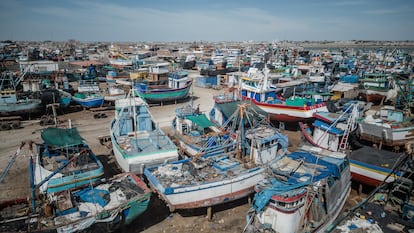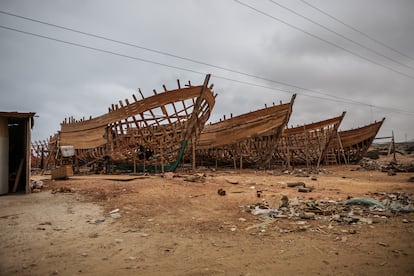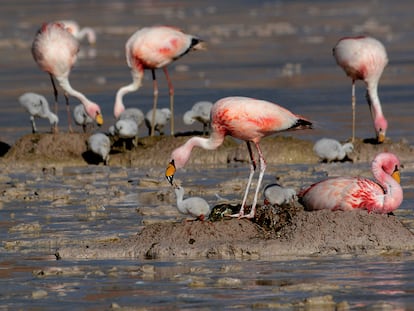Illegal shipyards threaten fishing in Peru
In 2015, the country prohibited the construction of artisanal boats. But they continued to be built informally, which is having dire impacts on the fertile Peruvian seas

“I no longer have resources, and there are no resources,” says Jacinto Galán, leader of the Association of Shipowners and Artisanal Fishermen of San José, a cove located in the city of Lambayeque, more than 700 kilometers (435 miles) north of Lima. The worry in his voice seems to get lost in the windy breeze, which whips across a very long dock that extends for nearly a kilometer.
Galán owns three artisanal fishing boats, which can carry up to 30 tons of fish or shellfish. He has just returned from a 15-day shift on one of them, several miles from the coast, and barely brought back two tons of catch. “It didn’t even cover my expenses,” he says, as the rough sea’s waves seem to try to flood the conversation.
Maritime labyrinth
The drama of this weathered man, who has been lost twice in the high seas, is shared by many of the fishermen in this country, where the fruits of the ocean constitute the most precious ingredients of its culinary art.

It has its origins in a very serious problem: artisanal boats are multitudinous, and biomass is shrinking. It’s necessary to go further and further out to sea to fish, sometimes to sparse results.
Even worse: despite Peruvian authorities announcing in 2015 that construction of artisanal boats (which have no mechanized gear) should be stopped so that species like the giant squid (dosidicus giga) do not disappear, illegal shipyards have popped up like so many wooden schools of fish along parts of the coastline.
EL PAÍS toured the coves of La Tortuga, Parachique and La Islilla, located in the north of the country, and found that ships are built in patios, yards and dusty pampas. There are towns that look almost like shipyards with houses built around them.

In 2015, the Peruvian state established the cessation of the construction of artisanal boats. There were already too many of them, and fishing ran the risk of becoming bad business that could not be passed on to future generations. However, in the more than seven years that have since passed, unauthorized vessels are still being built, and even sailing out onto the waves.
Today, the Peruvian artisanal fleet is estimated at more than 18,000 vessels. In 2018, informed of abundant illegality and informality, the country’s Ministry of Production created the Artisanal Fishing Formalization System (SIFORPA), to which 4,854 vessels applied.
By the deadline in July 2023, only 2,490 had passed the verification process. More than 2,000 submitted applications remained, which reveals the level of informality that navigates these waters. Add to this other issues, such as the covert registration of large ships as smaller vessels. In short, supreme disorder.
What the waves hide
“Before, we would go out to fish at 4 a.m. and be back by midnight, with 12 or 13 tons of catch. Now, it takes days. Or we have to move to other parts of the coast, because here’s it’s become difficult,” says Carlos Yenque, manager of the National Society of Artisanal Fishing and owner of boats.
His story seems to sink amid the waves at the port of Paita, as he navigates between numerous anchored artisanal boats. “That one, for example, has a registration starting with BM, which corresponds to a small ship, carrying up to seven tons, but you can see that it’s much bigger. It should say CM,” he says, with some indignation.
This is an old trick, typical of extralegal fishing chicanery. Not only are new boats being built, which will increase pressure on the marine species caught by these vessels, which in addition to the giant squid include the ‘perico’ (Coryphaena hippurus) fish, but also, the registration of existing boats is being shamelessly altered.

A small boat, according to Yenque, has a length of 29.5 feet, a width of 10.5 feet and can carry some seven tons. These metrics correspond to a BM registration. A large boat is about 46 feet long, has a width of 16.4 feet and can carry up to 32 tons. As we watch, however, several large vessels sail in front of us, decidedly not BM, even though that is what is proclaimed by their registration plates.
The unfortunate consequence of this is that, although a boat may be registered, its stated size may not be accurate. As such, it overfishes by passing itself off as a smaller boat. As if that were not enough, some license plates are cloned. Galán says a friend of his told him that, while he was unloading his catch in Paita, he found out that another vessel with an identical registration was doing the same in Chimbote, some 600 kilometers to the south.
Of course, this flotilla of tactics to evade registration does not float atop a clear sea. Widespread corrupt practices and a lack of ethical supervision are rife. In the Paita area, according to Yenque, two Ministry of Production supervisors are in charge of monitoring 14 unloading docks. Elsewhere on the coast, the backup is similar.
Goodbye biomass?
Great regulations, but little compliance; lack of state control on land and at sea; many boats, little catch. All this, despite the fact that the Peruvian Institute of the Sea (IMARPE) reported last November that the total harvest of squid decreased in recent years. It had previously warned that climate change would alter the sea’s productivity.
Even so, since 2022, member of Congress José Pazo — who is a fishing boat owner — has been promoting a law that would extend the deadline for the registration of vessels by one year, and would authorize some 1,000 more boats, as if the sea could withstand them. The proposal has not yet been approved.
Elsewhere, a law that has been proposed by legislator Norma Yarrow that would criminalize the construction of illegal boats in the country’s penal code has already been approved by Congress. But it remains to be seen what the effects of this law will be, and other problems associated with illegal fishing continue. For example: authorities have yet to clarify the regulation associated with Law 31749, which recognizes traditional ancestral fishing and traditional artisanal fishing, and which has set aside five miles of ocean closest to the coastline for these activities. It is meant to avoid, among other dangers, trawling carried out by industrial ships in this area.

This would favor fishermen like Felix Panta, who in the same town of Paita fishes near the coast for species like cachema (Cynoscion analis) and suco (Palonchorus peruanus), which go directly to local markets, while squid typically goes to processing centers for exportation. In Peru, fishing regulation is like a ship adrift at sea.
A 2020 study titled Growing Into Poverty: Reconstructing Peruvian Small-Scale Fishing Effort Between 1950 and 2018 concluded that the Peruvian seas are so exploited by the growth of the fishing fleet that it has dragged many fishermen into poverty. It’s getting worse all the time. The giant squid is going far away, getting scarcer, or diving deeper due to the climate; fish are no longer readily available by fishing from an island or a cliff. The supply of ceviche could even be affected, one day.
Sign up for our weekly newsletter to get more English-language news coverage from EL PAÍS USA Edition
Tu suscripción se está usando en otro dispositivo
¿Quieres añadir otro usuario a tu suscripción?
Si continúas leyendo en este dispositivo, no se podrá leer en el otro.
FlechaTu suscripción se está usando en otro dispositivo y solo puedes acceder a EL PAÍS desde un dispositivo a la vez.
Si quieres compartir tu cuenta, cambia tu suscripción a la modalidad Premium, así podrás añadir otro usuario. Cada uno accederá con su propia cuenta de email, lo que os permitirá personalizar vuestra experiencia en EL PAÍS.
¿Tienes una suscripción de empresa? Accede aquí para contratar más cuentas.
En el caso de no saber quién está usando tu cuenta, te recomendamos cambiar tu contraseña aquí.
Si decides continuar compartiendo tu cuenta, este mensaje se mostrará en tu dispositivo y en el de la otra persona que está usando tu cuenta de forma indefinida, afectando a tu experiencia de lectura. Puedes consultar aquí los términos y condiciones de la suscripción digital.
More information

The rise of lithium mining threatens the Andean flamingo in Argentina
Archived In
Últimas noticias
A hybrid building: Soccer pitch, housing, and a shopping mall
Europe urges Trump to respect Greenland following annexation threats
Science seeks keys to human longevity in the genetic mixing of Brazilian supercentenarians
Luisa Neubauer, climate change activist: ‘Ecology shouldn’t be a punitive force, but a joyful and liberating one’
Most viewed
- Alain Aspect, Nobel laureate in physics: ‘Einstein was so smart that he would have had to recognize quantum entanglement’
- Alvin Hellerstein, a 92-year-old judge appointed by Bill Clinton, to preside over Maduro’s trial in New York
- Cuba confirms death of 32 of its citizens in the US attack against Venezuela
- Gilles Lipovetsky: ‘If you want to live better and fall in love, take Prozac, don’t look to philosophy’
- Why oil has been at the center of Venezuela-US conflicts for decades









































